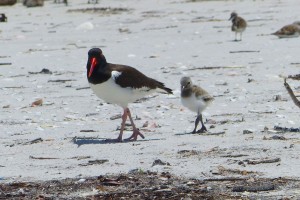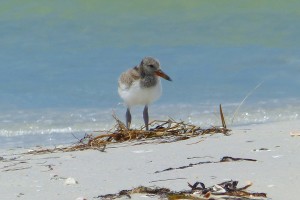
This is what we want to see! Photo courtesy of awesome bird steward Lorraine Margeson. Fort Desoto Park, 2015
When I approach the island, even before my kayak nudges into the sand, the first thing I look for are possible predators: crows, osprey, eagle, laughing gull—or the tracks of a trespassing human. I’m surprised to see the broad wings of a turkey vulture skimming over the sand, tilting on the updrafts, on the look out for food. Right on its tail, three American oystercatchers escort the vulture off the island. They pipe loudly and push the vulture out of their airspace with their long orange bills. Something’s going on here!
The spoil island is aesthetically unpleasant. Its shape and composition don’t make sense to the eye as a natural feature, because it is not. But in some ways, it works for beach-nesting shorebirds, because it’s been raised above the tide by dredge material from a nearby channel, and it is out of reach for coyotes, feral hogs and cats, and raccoons.
I make my way around the tiny island with my spotting scope over my shoulder and my binoculars around my neck. I move slowly, keeping count of all the birds I see. But my assigned task is to locate and keep track of nesting shorebirds, especially least terns, black skimmers, certain small plovers, or oystercatchers.
This is my third visit to the island this season, so I’m pretty certain there are no colonies of least terns here. But I’ve seen pairs of oystercatchers slipping around like shadows, so I’m looking for them in particular. My eyes key in on the shape of a large ebony bird sitting on the sand. It startles away. I fix in my mind where I first spotted the bird—triangulated between a broken plastic bucket in the sand, and a certain white morning glory blossom.
And there they are: three eggs marbled brown and black, fragile as snowflakes on the sand. An extra high tide could so easily wash them away. A crow or a large gull could devour them. Or if all goes well, the line of oystercatchers might continue another generation.
Away I went, on around the island. Eventually, I found three nests spaced the length of a football field from one another, creating a nearly equilateral triangle of nest points, as far apart as the dry land could serve.
And then the thing that I never imagined getting to see for myself, in the last of the nests: the tip of the bill of an oystercatcher chick, meeting the salt air for the first time, encountering its place in this world. At first, I thought the hole meant that the egg must be damaged. Had ants punctured it, or was the eggshell thinned and then fractured by the weight of the parents’ bodies? But no…there at the center of the hole…that was the tiny bill of a new rare life. I allowed myself only the barest moment to ascertain that all was well, for the parent bird was circling wide, silent arcs out over of the water and back. I needed to leave the eggs under the protection of their own parent, even though my instinct was to kneel down and stay.
How fearsome I was to that parent bird, with my spider-like a tripod and upright slow-moving body. Imagine if the only way we could protect our newborn was to draw the predator away with our own bodies and our own voices, implying there’s no nest, no chicks, no eggs, keep your eye on me, let me draw you far away from what I am trying to bring into the world.
As I paddled away from the island, I was awash in gratitude and awe. Though I wasn’t welcome to watch, I knew the hatch of that chick would be as miraculous and sacred as the birth of any other species on earth.
NOTE: Never, ever trespass into a posted shorebird nesting area. This is an utterly essential time in their lives. If parents are forced away from their nests, chicks can die from exposure to sun, or fall victim to ever-hungry predators.
ANOTHER NOTE: Want to help monitor and steward shorebirds? Your karma will be greatly increased! If you live in north Florida, contact Bonnie Samuelson, who is in charge of Coastal Bird Stewardship, at 941-951-7704 or bsamuelsen@audubon.org
Share On:




Oval orbs of hope. What a gift to us this morning. Oh, and your book is a marvel. Reading it aloud to us every night before sleep.
Lovely Sue. Wish I could have been there with you!
Definitely, a sacred birth. Thanks for writing about it.